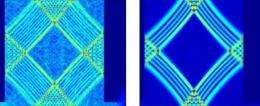May 10, 2010 feature
New evidence for quantum Darwinism found in quantum dots

(PhysOrg.com) -- Physicists have found new evidence that supports the theory of quantum Darwinism, the idea that the transition from the quantum to the classical world occurs due to a quantum form of natural selection. By explaining how the classical world emerges from the quantum world, quantum Darwinism could shed light on one of the most challenging questions in physics of the past century.
The basis of almost any theoretical quantum-to-classical transition lies in the concept of decoherence. In the quantum world, many possible quantum states “collapse” into a single state due to interactions with the environment. To quantum Darwinists, decoherence is a selection process, and the final, stable state is called a “pointer state.” Although pointer states are quantum states, they are “fit enough” to be transmitted through the environment without collapsing and can then make copies of themselves that can be observed on the macroscopic scale. Although everything in our world is quantum at its core, our classical view of the universe is ultimately determined by these pointer states.
Since quantum Darwinism was first proposed in 2003 by Wojciech Zurek of Los Alamos National Laboratory, several studies have found evidence to support the idea. Most recently, a team of physicists and engineers from Arizona State University and the Naval Research Laboratory in Washington, D.C., has performed experiments using scanning gate microscopy to image scar structures in an open quantum dot. Their results have revealed the existence of periodic scar offspring states that evolve and eventually contribute to a robust state, much in the way that the derivation of pointer states is predicted by quantum Darwinism.
The “scars,” as the researchers explained, are actually scarring on the quantum wave functions, which cause the wave functions’ amplitudes to be highly concentrated along classical trajectories. Scars are traditionally thought to be unstable, where any small perturbation could break up the connection to the classical trajectory. However, when scar states replicate and evolve through quantum Darwinism, becoming a family of mother-daughter states, they can become coherent and eventually stabilize into multiple pointer states.
To detect this scar replication, the researchers used scanning gate microscopy to scan a conductive tip over the scar structures at a constant height. The tip acts as a local perturbation by causing a change in electrical conductance proportional to the sample’s electron density at that location. By measuring the change in conductance at different locations, the technique revealed that the scar structures have a periodic magnetic field that fits well with the idea of periodic offspring states.
“The magnetic periodicity, which we used to get the experimental data results, is the ‘smoking gun’ for quantum Darwinism,” coauthor David Ferry of Arizona State University told PhysOrg.com.
The agreement of the experimentally derived patterns and simulation patterns during variations in conductance also supports the idea that these periodic patterns represent offspring states. As the scientists explain, when the magnetic field increases, these offspring modes “push through” an energy level called the Fermi level and emerge as pointer states, which are detectable.
The ability of pointer states to make copies of themselves and produce descendants, as shown in these observations, is a key requirement of quantum Darwinism. By demonstrating this pointer state evolution in the scar structures of an open quantum dot, the physicists’ discovery provides evidence for the theory of quantum Darwinism - and, in turn, why we live in a classical world that is free from quantum effects such as superposition and uncertainty. Still, as Ferry explained, more work is needed before the theory becomes widely accepted.
“It is a theory, and our data provides support,” he said. “But, the experiments have to be confirmed by other groups, perhaps many times if the theory is to be fully accepted.”
More information: A.M. Burke. “Periodic Scarred States in Open Quantum Dots as Evidence of Quantum Darwinism.” Physical Review Letters 104, 176801 (2010). Doi:10.1103/PhysRevLett.104.176801
Copyright 2010 PhysOrg.com.
All rights reserved. This material may not be published, broadcast, rewritten or redistributed in whole or part without the express written permission of PhysOrg.com.















